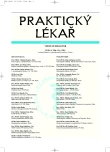Patent foramen ovale as a cause of paradoxical embolization in scuba divers. Screening possibilities, therapeutic and preventive recommendation.
Authors:
T. Honěk 1; A. Tomek 2; M. Šrámek 2; J. Januška 3; L. Šefc 4; R. Kerekeš 5; Š. Novotný 6; J. Honěk 4; J. Veselka 1
Authors‘ workplace:
Kardiovaskulární centrum FN Motol, Praha
Přednosta: Doc. MUDr. Josef Veselka, CSc.
1; Neurologická Klinika FN Motol, Praha
Přednosta: doc. MUDr. Martin Bojar, CSc.
2; Kardiocentrum Nemocnice Podlesí a. s., Třinec
Vedoucí lékař: prim. MUDr. Marian Branný
3; Ústav patologické fyziologie 1. LF UK, Praha
Přednosta: prof. MUDr. Emanuel Nečas, DrSc.
4; Interní oddělení SZZ Krnov
Primář: MUDr. Naděžda Mičudová
5; Hyperbarická komora a poradna pro potápěče, Kladno
Vedoucí: MUDr. Štěpán Novotný
6
Published in:
Prakt. Lék. 2007; 87(1): 48-51
Category:
Diagnostis
Overview
Introduction:
The formation of nitrogen bubbles in venous blood is common in a surfacing scuba-diver. Bubbles can pass through a patent foramen ovale (PFO) and can be a source for paradoxical embolization, resulting in the neurological form of decompression sickness (DCS).
Methods:
We examined 32 scuba divers who had performed more than 100 dives. Right to left shunt detection suggesting the presence of PFO was detected by bubble contrast examination in all divers by means of transthoracic echocardiography (TTE) and transcranial Doppler sonography (TCD). The diagnosis of PFO was then made by means of transoesophageal echocardiography (TEE).
Results:
Eleven patients had symptoms typical for the neurological form of DCS associated with an ascent. In this group, 91% (10/11) had PFO. In contrast only 10% of asymptomatic controls (2/21) had a PFO. TCD confirmed right to left shunting in all patients with PFO.
Conclusion:
The neurological form of DCS can unmask as yet asymptomatic intracardiac right to left shunting. PFO represents a risk factor for the neurological form of DCS in divers. TCD enables easy screening and TEE is a gold standard for PFO diagnostics. Our results demonstrated that PFO detection is a useful clinical tool after repeat neurological DCS and should also be used for all frequent divers and instructors.
Key words:
patent foramen ovale, scuba diving, decompression sickness
Labels
General practitioner for children and adolescents General practitioner for adultsArticle was published in
General Practitioner

2007 Issue 1
Most read in this issue
- Chronic renal failure in primary care
- Craniopharyngioma in 79 years old man – a case study
- Wilson’s disease
- Hypoglycaemia-associated autonomic failure, its clinical assessment and treatment.
